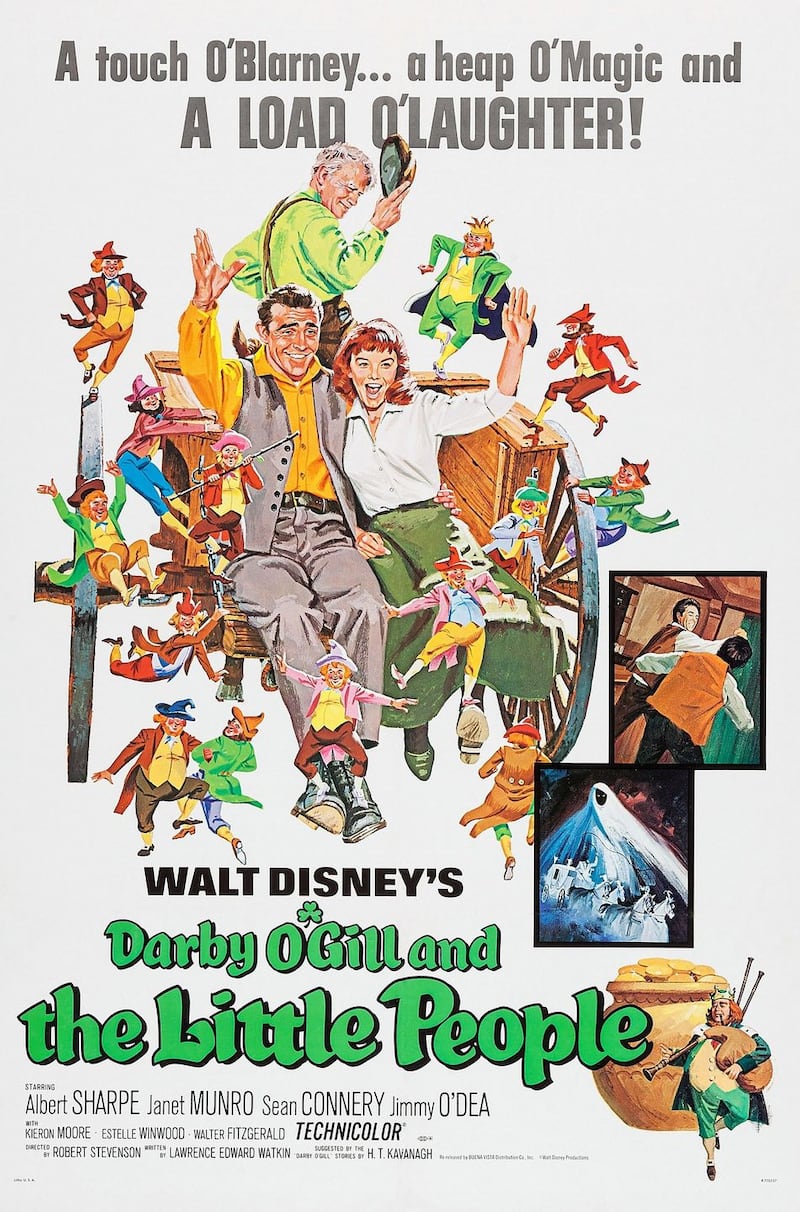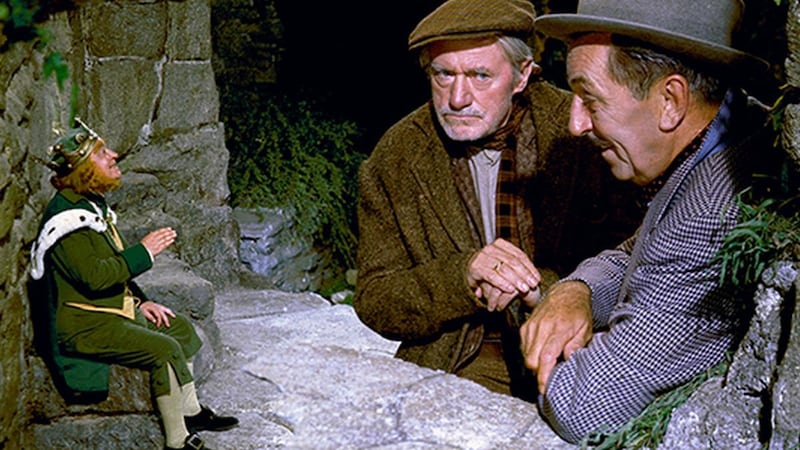As the vast majority of the action and the most famous scenes from John Ford’s Oscar-winning 1952 classic The Quiet Man take place in an idyllic, unspoiled approximation of the Irish countryside, it is easy to neglect the film’s brief flashback sequences that are set in the US. And yet its depiction of life in America, however fleetingly rendered, is as important as its depiction of life in Ireland to the film’s instant and enduring appeal among the Irish diaspora in the United States.
While there have been many before it and after it, The Quiet Man is certainly the most iconic and arguably the best example of a Hollywood film about Ireland and Irish people that is structured around the narrative of return from the diasporic space of Irish America to the homeland of Ireland. The protagonist of this particular type of film is always Irish-American, usually a man approaching middle age and grappling with a major problem which can only be solved by returning to the homeland.
The harrowing flashback sequences in The Quiet Man reveal the reason behind the decision of John Wayne's monosyllabic protagonist Sean Thornton to return to Inishfree and start his life afresh. He is traumatised after accidentally killing an opponent as a champion prizefighter in Pittsburgh and is seeking spiritual and emotional renewal, although he can't quite articulate this himself. Return to Ireland is presented as an appealingly restorative and transformative experience for Sean Thornton.
Despite certain cast members' accents, Darby O'Gill and the Little People featured a cast of exclusively Irish characters, and America was mentioned only once
Throughout the film, he reacquaints himself with a world untroubled by modernity, progress, major conflict and their attendant complications and, crucially, with a world in which he feels he belongs on account of his Irish heritage. It is poignant to consider the extent to which the return narrative with this diasporic wish-fulfilment fantasy at its core thrived at the American box office in the period immediately following the end of the second World War in Irish-themed Hollywood films such The Luck of the Irish (1948) and Top O’ the Morning (1949) as well as in The Quiet Man.
Despite all three Irish-themed Hollywood films achieving success, The Quiet Man, the film in which the connection between post-war trauma in the United States and audiences' willingness to embrace the return narrative is most explicitly articulated, scaled new heights of success for Irish representation in mainstream American cinema, winning two Academy Awards and becoming one of the top 10 highest-grossing films domestically that year.
The Irish-American return narrative would feature prominently again later that same decade in 1959 when Walt Disney Productions, having first announced their forthcoming Irish-themed project in 1945 before shelving it for several years due to severe financial constraints, finally released Darby O'Gill and the Little People. Loosely adapted from a collection of brilliantly subversive, proto-feminist fairy tales by Irish-American children's author Herminie Templeton Kavanagh, the film was set exclusively in Ireland and featured a cast of exclusively Irish characters – despite the accents used by certain cast members suggesting otherwise – and America is only mentioned once throughout the whole film.

In this case, the return narrative is not woven into the film but into the sophisticated and extensive publicity campaign personally overseen by Walt Disney. The intentions of Walt Disney Productions are stated unequivocally in a document which was circulated around the publicity department at the company's Burbank facility in anticipation of the film's release, which took place on June 26th, 1959, 60 years ago this week.
The document begins by saying the campaign will be conducted through the usual channels as heretofore, before asserting that “Unlike previous campaigns, Darby O’Gill will have a ready-made market potential of 20 million Irish-Americans. Special attention will be paid to these people with shamrocks in their eyes. Their numbers alone could carry the picture to big box-office earnings.”
The Disney publicity team set about targeting Irish-American societies and associations, as well as general media outlets in cities with large Irish-American populations such as New York, Boston, Chicago, Pittsburgh and Philadelphia and the fire and police departments of those cities which were known to have a considerable number of Irish Americans in their ranks. The targeting of Irish Americans also featured prominently when the publicity team employed two vital tools in their arsenal, the company's official publication, Walt Disney's Magazine, and the company's official television programme, the anthology series Disneyland, which was broadcast across the US on the ABC network.
In the fictionalised account, 'half-Irish' Walt grew up in Missouri hearing stories of the leprechauns of Ireland and determined to one day make a film on that very subject
In an article from the February 1959 edition of Walt Disney's Magazine and a special episode of Disneyland broadcast on May 29th, Walt Disney is presented as the Irish-American protagonist. For the purposes of promoting Darby O'Gill and the Little People, the ever-shrewd Disney happily reconfigured his own ethnic identity for a brief period and declared himself to be "half-Irish". However overstated and opportunistic this sudden declaration may have been, it was not entirely disingenuous, his great-grandfather Arundel Elias Disney having emigrated to America from Gowran, Co Kilkenny, in 1823.
The magazine article “How I Met the King of the Leprechauns” and the television special I Met the King of the Leprechauns both offer an alternative, fictionalised account of the making of the film in which “half-Irish” Walt grew up on his family farm in Marceline, Missouri, hearing stories of the leprechauns of Ireland and became determined to one day make a film on that very subject. He works tirelessly to realise his vision but his attempts to render leprechauns convincingly on screen through every cinematic trick that he knows are all, we are told, spectacular failures.
Disney therefore becomes the Irish-American for whom a major problem has arisen in the diasporic space. He is not traumatised like Sean Thornton in The Quiet Man, disillusioned with modern American life like Stephen Fitzgerald in The Luck of the Irish or personally unfulfilled like Joe Mulqueen in Top O' the Morning. Instead, Disney is in desperate need of real leprechauns and, although their problems are radically different from his, the solution ultimately proves the same as it does for the beleaguered Irish-American protagonist in all three of those films as Disney returns to Ireland and his problems are solved in the homeland.
In both the magazine article and the television special, on arriving back in Ireland, Disney consults with a folklore scholar in Dublin regarding his predicament and is advised to contact Darby O’Gill, whose knowledge of leprechauns is unparalleled. Darby willingly obliges and arranges an audience between Disney and King Brian Connors of the Little People. The fairy king’s unfriendly and suspicious demeanour changes utterly once he learns of Walt’s Irish heritage and both the magazine article and television special conclude on a triumphant note as King Brian enthusiastically agrees to travel to Walt’s state-of-the-art studios in California and appear in the film alongside 150 of his followers.

Further documents circulated around the publicity department of Walt Disney Productions reveal that it was Walt Disney who insisted on both the “tongue-in-cheek” assertion of the use of actual leprechauns in the film and the appropriation of the Irish-American return narrative being fundamental to the campaign surrounding the film’s release. Thus, a curious amalgamation was produced which added a layer of actual fantasy onto what was essentially already a fantasy, albeit one based upon diasporic wish-fulfilment rather than leprechauns.
Disney was convinced that both the leprechaun assertion and the return narrative featuring himself as the returning Irish American would engage and entertain the Irish in America, children and adults, men and women and first-generation and sixth-generation alike, and persuade them to go and see Darby O'Gill and the Little People in their millions. So convinced, he commissioned John Conner of the publicity department to write the magazine article in the first-person guise of Disney and the film's screenwriter Lawrence Edward Watkin to write the script for the television special, in which scenes from the completed feature film were intercut with exclusive extra scenes featuring Disney as himself, Albert Sharpe as Darby and Jimmy O'Dea as King Brian, in which the narrative of Disney's return plays out.
The assertion of the use of actual leprechauns and the great lengths to which Disney personnel went to maintain this illusion on Walt's orders had unfortunate consequences for O'Dea, who spent an arduous five months filming in California in the summer of 1958 for the feature film and the television special. The shooting hours for O'Dea were long and tedious as Disney's pioneering visual effects expert Peter Ellerenshaw painstakingly executed the "forced perspective" technique integral to realising his character King Brian Connors on screen.
The film performed well but not spectacularly, and the publicity campaign certainly did not persuade 20 million Irish Americans 'with shamrocks in their eyes' to go and see it
O’Dea, a beloved comedian and actor in Ireland, was nevertheless reassured by the prospect of the inevitable international opportunities that would arise from such a high-profile Hollywood role. He intended to use Darby O’Gill and the Little People as a calling card for future film projects and yet, as it transpired, he was practically invisible in the publicity materials surrounding the film’s release.
Profiles of all the actors in the film, including Sean Connery, who would achieve worldwide stardom three years later when he starred as James Bond in Dr No, were produced and disseminated to media outlets across the US. While a profile of O'Dea was produced, it was never disseminated. His bewilderment and disappointment upon discovering Disney's plans for his invisibility are movingly evident in letters which he wrote home from California to his sister, Rita.
Ultimately, the film performed well but not spectacularly and the publicity campaign certainly did not persuade 20 million Irish Americans “with shamrocks in their eyes” to go and see it.
Seven years had passed since the release of The Quiet Man and cold war anxieties may have replaced post-war trauma to such an extent in the Irish-American consciousness. It is also possible that Walt Disney and his team made a major miscalculation with their singular version of the return narrative. From the early decades of the 19th century, long before the invention of cinema, Irish-American culture has been founded and built upon the impenetrable distinctions between life as it is lived in the homeland and life as it is lived in the diasporic space.
As sentimental magazine serials, comedy sketches on the vaudevillian stage and the Kalem Company films of the 1910s all testify, Ireland is the land of tradition, simplicity and imagination and America is the land of modernity, advancement and reality and never the twain shall meet. One should by all means return to Ireland in order to regress, as Sean Thornton needed to in The Quiet Man, but one should never consider Ireland as a place to progress. Uniquely Irish tales of leprechauns may capture the imagination of an Irish American, and frequently do, but that is where they must firmly stay, in the land of the imagination.
For many Irish Americans, Disney’s tales of King Brian and his leprechauns travelling over to glamorous, urbane and fatally modern California to star in a Hollywood film may have proven too bizarre to be borne.
Dr Brian McManus is a scholar of children’s literature and film currently associated with Trinity College Dublin and Maynooth University. He will be speaking about the 60th anniversary of Darby O’Gill and the Little People at the Warp & Weft of Heritage Weekend in Ardara, Co Donegal, October 11th-13th














